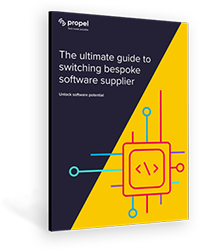24/01/2024
Is it time to evaluate and potentially switch your bespoke software partner?
60% of companies outsource some bespoke software management in 2023*
With software development outsourcing being seen as an antidote to economic uncertainty, there has never been a more pressing time to ensure you have the right partner in place. Propel Tech’s years of experience working with clients across multiple sectors have given our team great insight into when and why businesses should consider changing their bespoke software solutions partner. Here we have compiled some key indicators that suggest it may be time to evaluate and potentially switch your bespoke software partner.
Lack of support and responsiveness:
Responsiveness is a basic, and fundamental measure of the health of a supplier relationship. Setting out and maintaining expectations of responsiveness, and embedding SLAs is imperative to success - it sets the playing field and ensures every party knows what is expected. If your current software partner consistently fails to provide adequate support or is unresponsive to your development needs, it can hinder your business operations. Delayed response times, unresolved issues, and a lack of proactive engagement indicate a breakdown in the partnership and may warrant exploring other options.
Outdated technology and functionality:
If your current software engineers or consultants are unable to advise on practices, maintain timely updates, not integrate modern features correctly, or fail to manage integrations with other essential tools, it may be holding your business back. Bespoke outsourced software partners should never let your technology become stagnant or outdated - even a legacy system should be optimised to its full potential and always kept up to date. The biggest costs and issues can arise when technology is left to stagnate.
Scalability limitations:
As your business grows, your software needs to scale accordingly. If your current software solutions provider cannot accommodate the increased workload or lacks the flexibility to adapt to changing business requirements, consider seeking a partner with a more scalable solution. Inadequate scalability can holdback expansion plans and your ability to meet customer demands.
Security concerns:
It's essential to prioritise the protection of your sensitive information. Switch to a software partner with a proven track record in security and robust data protection. A good measure is to check if your supplier or prospective supplier has gained any certificates and external stamps of approval for example, ISO 9001 and ISO 27001, which are both internationally recognised standards for Quality Management Systems (QMS) and data management. They set out the criteria for a quality management system and a compliant information security management system that can help protect sensitive data from cybercriminals.
Cost inefficiencies:
High maintenance costs, licensing fees, or customisation expenses can significantly impact your bottom line. If you find that your current software partner is not cost-effective or fails to deliver sufficient ROI, review alternative options that offer better value for your investment.
Competitive disadvantage:
Consider if your competitors are utilising more advanced software solutions or are leveraging technology to gain a competitive edge. Falling behind technologically can impede your ability to innovate, deliver superior customer experiences, and stay ahead in the market.
Organisational growth or restructuring:
Mergers, acquisitions, or significant organisational changes can necessitate a reassessment of your software partnership. Aligning your software solutions with your new structure and goals can improve operational efficiency and streamline processes.
“Any bespoke software supplier needs to be an extension of my team, with us for the journey, adding value by immersing in my business to solve the right problems to deliver.” Mick Roscoe - Software Delivery Manager - Your Move
Seven key tips to assess and manage a switch in suppliers
Wil Jones, our Technical Director, shares insights into how to change bespoke software suppliers to minimise risk and maximise the impact:
- Assess your needs and goals:
Before making the switch, take the time to evaluate your current software and identify its limitations or areas for improvement. Clearly define your objectives and prioritise the features and functionality you require from the new software supplier. This will help you find the right fit and streamline the transition process.
- Research and due diligence:
Thoroughly research potential software suppliers to ensure they have a proven track record and a good reputation in your industry. Look for case studies and testimonials to gain insights into their expertise and reliability. Additionally, consider their compatibility with your existing infrastructure and future scalability.
- Plan for a phased transition:
Attempting to switch your software supplier quickly can lead to significant downtime and disruptions. Instead, if possible, plan for a phased transition approach. Identify critical functions and prioritise the initial implementation, gradually expanding into other areas. This way, you can minimise downtime and ensure effectiveness in a controlled manner.
- Ensure data compatibility and migration:
Data migration is a crucial aspect of switching software suppliers. Work closely with both the existing and new suppliers to ensure a smooth transfer of data. Verify that your data formats are compatible and establish clear protocols for the migration process. Conduct extensive testing to ensure data integrity and validate that all vital information has been successfully transferred.
- Communication and change management:
Effective communication is paramount throughout the transition process. Keep all stakeholders informed about the switch, its benefits, and the anticipated timeline. Create a change management plan that addresses potential resistance and provides support mechanisms for employees. Encourage feedback and address concerns promptly to foster a smooth transition.
- Test thoroughly before going live:
Perform extensive testing of software, and changes in a controlled environment. Conduct user testing to ensure that all functionality works as expected and meets your business requirements. Identify and rectify any issues before going live to minimise disruptions once the migration has taken place.
- Monitor and evaluate performance:
After the transition, closely monitor the performance of your bespoke software partner to ensure that they meet your expectations. Regularly assess their impact on productivity, efficiency, and overall business outcomes. Collect feedback from end-users and make necessary adjustments or optimisations to maximise the benefits of outsourcing.
By following these strategies and considerations, you'll be better equipped to navigate the transition successfully and optimise the benefits of your new software supplier.
Read our case studies: https://propeltech.co.uk/projects/
*Sources: Statista global software outsourcing data 2023

eBook
Make successful provider migrations a possibility. Download our essential free guide.
Find out more





